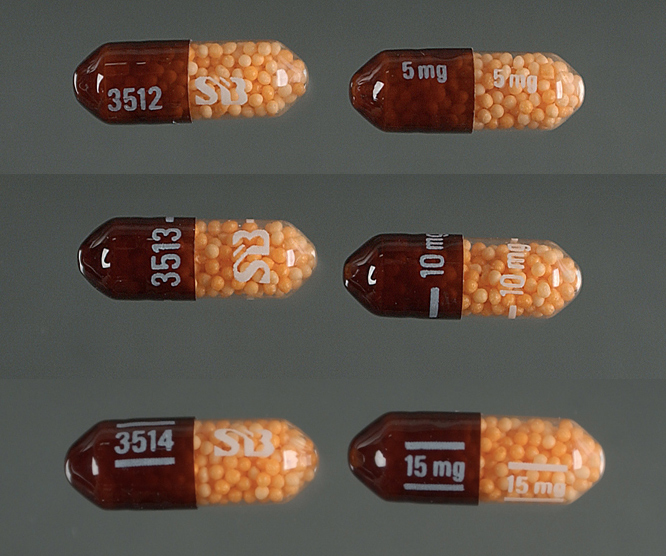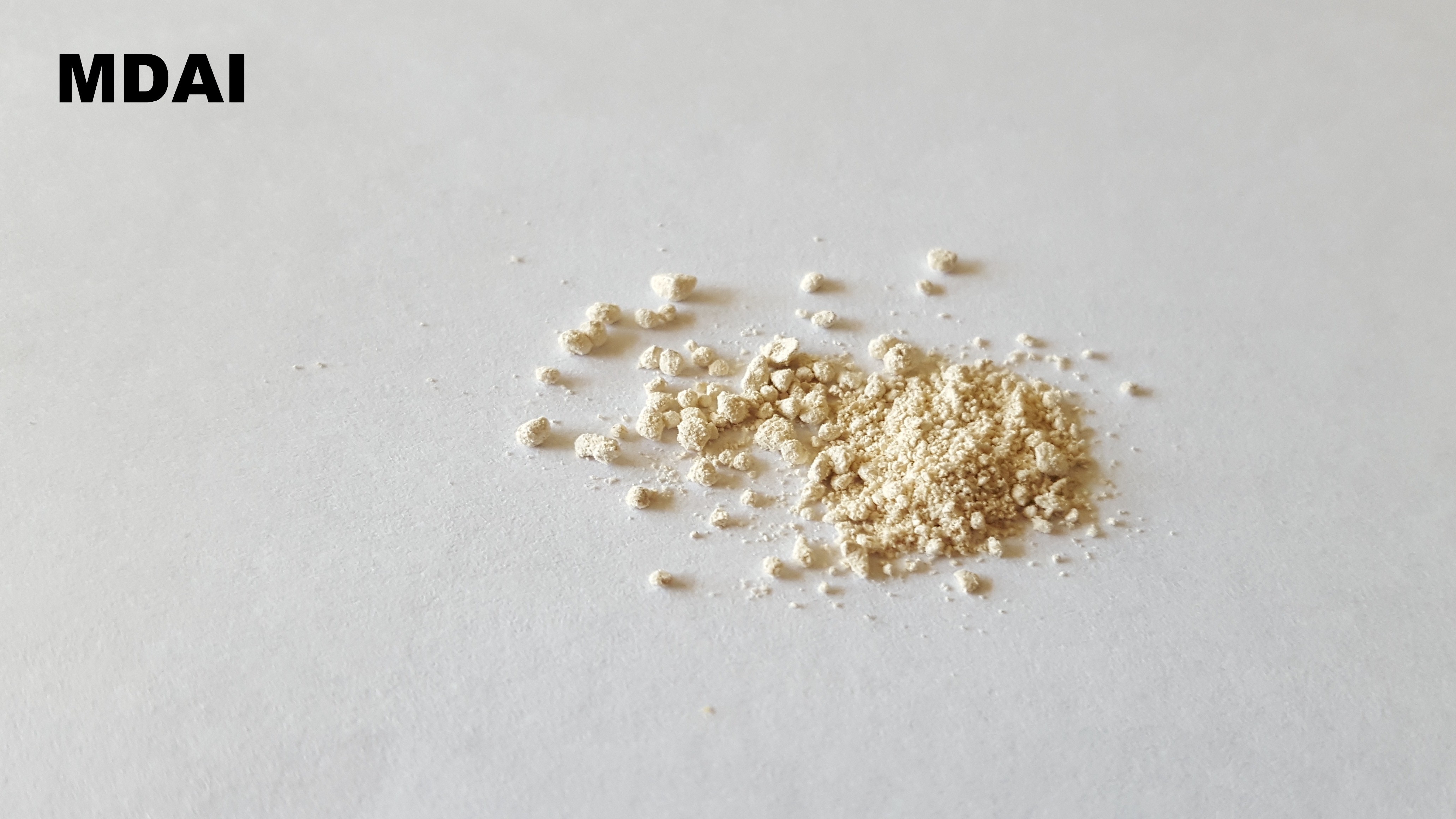|
MEAI (drug)
MEAI, also known as 5-methoxy-2-aminoindane (5-MeO-AI), is a monoamine releasing agent of the 2-aminoindane group. It specifically acts as a selective serotonin releasing agent (SSRA). The drug is under development for the treatment of alcoholism, cocaine use disorder, metabolic syndrome, and obesity under the developmental code name CMND-100. Effects When used recreationally, MEAI is reported to produce mild psychoactive effects and euphoria. Pharmacology Pharmacodynamics MEAI is a monoamine releasing agent (MRA). It is a modestly selective serotonin releasing agent (SSRA), with 6-fold preference for induction of serotonin release over norepinephrine release and 20-fold preference for induction of serotonin release over dopamine release. In addition to inducing monoamine neurotransmitter release, MEAI has moderate affinity for the α2-adrenergic receptor. Based on these findings, MEAI might produce MDMA-like entactogenic and sympathomimetic effects but may be expected to ha ... [...More Info...] [...Related Items...] OR: [Wikipedia] [Google] [Baidu] |
Monoamine Releasing Agent
A monoamine releasing agent (MRA), or simply monoamine releaser, is a drug that induces the release of one or more monoamine neurotransmitters from the presynaptic neuron into the synapse, leading to an increase in the extracellular concentrations of the neurotransmitters and hence enhanced signaling by those neurotransmitters. The monoamine neurotransmitters include serotonin, norepinephrine, and dopamine; MRAs can induce the release of one or more of these neurotransmitters. MRAs work by reversing the direction of the monoamine transporters (MATs), including the serotonin transporter (SERT), norepinephrine transporter (NET), and/or dopamine transporter (DAT), causing them to promote efflux of non-vesicular cytoplasmic monoamine neurotransmitter rather than reuptake of synaptic monoamine neurotransmitter. Many, but not all MRAs, also reverse the direction of the vesicular monoamine transporter 2 (VMAT2), thereby additionally resulting in efflux of vesicular monoamine neuro ... [...More Info...] [...Related Items...] OR: [Wikipedia] [Google] [Baidu] |
Alpha-2 Adrenergic Receptor
The alpha-2 (α2) adrenergic receptor (or adrenoceptor) is a G protein-coupled receptor (GPCR) associated with the Gi alpha subunit, Gi heterotrimeric G-protein. It consists of three highly homologous subtypes, including α2A-adrenergic, α2A-, α2B-adrenergic, α2B-, and α2C-adrenergic, α2C-adrenergic. Some species other than humans express a fourth α2D-adrenergic receptor as well. Catecholamines like norepinephrine (noradrenaline) and epinephrine (adrenaline) signal through the α2-adrenergic receptor in the central nervous system, central and peripheral nervous systems. Cellular localization The Alpha-2A adrenergic receptor, α2A adrenergic receptor is localised in the following central nervous system (CNS) structures: * Brainstem (especially the locus coeruleus as presynaptic & somatodendritic autoreceptor ) * Midbrain * Hypothalamus * Olfactory system * Hippocampus * Spinal cord * Cerebral cortex * Cerebellum * Septum Whereas the Alpha-2B adrenergic receptor, α2B adren ... [...More Info...] [...Related Items...] OR: [Wikipedia] [Google] [Baidu] |
Dextroamphetamine
Dextroamphetamine (international nonproprietary name, INN: dexamfetamine) is a potent central nervous system (CNS) stimulant and enantiomer of amphetamine that is used in the treatment of attention deficit hyperactivity disorder (ADHD) and narcolepsy. It is also used illicitly to enhance Nootropic, cognitive and athletic Performance-enhancing substance, performance, and recreationally as an aphrodisiac and euphoriant. Dextroamphetamine is generally regarded as the prototype drug, prototypical stimulant. The amphetamine molecule exists as two enantiomers, levoamphetamine and dextroamphetamine. Dextroamphetamine is the Levorotation and dextrorotation, dextrorotatory, or 'right-handed', enantiomer and exhibits more pronounced effects on the central nervous system than levoamphetamine. Pharmaceutical dextroamphetamine sulfate is available as both a brand name and generic drug in a variety of dosage forms. Dextroamphetamine is sometimes prescribed as the inactive prodrug lisdexamfet ... [...More Info...] [...Related Items...] OR: [Wikipedia] [Google] [Baidu] |
5-Methoxy-6-methyl-2-aminoindane
5-Methoxy-6-methyl-2-aminoindane (MMAI) is a drug of the 2-aminoindane group developed in the 1990s by a team led by David E. Nichols at Purdue University. It acts as a less neurotoxic and highly selective serotonin releasing agent (SSRA) and produces entactogenic effects in humans. It has been sold as a designer drug and research chemical online since 2010. The drug is one of the only known monoamine releasing agents (MRAs) with greater than 100-fold selectivity for the serotonin transporter (SERT) over the dopamine transporter (DAT). Receptor interaction data for MMAI have also been reported. MMAI has been shown to relieve stress-induced depression in rats more robustly than sertraline, and as a result it has been suggested that SSRAs like MMAI and 4-methylthioamphetamine (4-MTA) could be developed as novel antidepressants with a faster onset of therapeutic action and superior effectiveness to current antidepressants such as the selective serotonin reuptake inhibitors (SSR ... [...More Info...] [...Related Items...] OR: [Wikipedia] [Google] [Baidu] |
5,6-Methylenedioxy-2-aminoindane
MDAI, also known as 5,6-methylenedioxy-2-aminoindane, is an entactogen drug of the 2-aminoindane group which is related to MDMA and produces similar subjective effects. It acts as a selective serotonin and norepinephrine releasing agent (SNRA). The drug shows greatly reduced serotonergic neurotoxicity in comparison to MDMA in animals, although it still shows weak capacity for neurotoxicity with chronic use or in combination with amphetamine. MDAI was developed in the 1990s by a team led by David E. Nichols at Purdue University. It has been encountered as a designer drug and has been used recreationally with reported street names such as "sparkle" and "mindy". In addition to its recreational use, there has been interest in MDAI for potential use in medicine, for instance in drug-assisted psychotherapy. Uses Scientific research MDAI and other similar drugs have been widely used in scientific research, as they are able to replicate many of the effects of MDMA, but without ca ... [...More Info...] [...Related Items...] OR: [Wikipedia] [Google] [Baidu] |
Dopamine Releasing Agent
A dopamine releasing agent (DRA) is a type of drug which induces the release of dopamine in the Body (biology), body and/or brain. No binding selectivity, selective DRAs are currently known. However, non-selective DRAs, including norepinephrine–dopamine releasing agents (NDRAs) like amphetamine and methamphetamine, serotonin–norepinephrine–dopamine releasing agents (SNDRAs) like MDMA and mephedrone, and serotonin–dopamine releasing agents (SDRAs) like 5-chloro-αMT and BK-NM-AMT, are known. A closely related type of drug is a dopamine reuptake inhibitor (DRI). In contrast to the case of DRAs, many selective DRIs are known. Examples of selective DRIs include amineptine, modafinil, and vanoxerine. Selectivity No binding selectivity, selective and robust DRAs are currently known. The lack of known selective DRAs is related to the fact that it has proven extremely difficult to separate dopamine transporter (DAT) affinity (pharmacology), affinity from norepinephrine transpo ... [...More Info...] [...Related Items...] OR: [Wikipedia] [Google] [Baidu] |
Norepinephrine Releasing Agent
A norepinephrine releasing agent (NRA), also known as an adrenergic releasing agent, is a catecholaminergic type of drug that induces the release of norepinephrine (noradrenaline) and epinephrine (adrenaline) from the pre-synaptic neuron into the synapse. This in turn leads to increased extracellular concentrations of norepinephrine and epinephrine therefore an increase in adrenergic neurotransmission. A closely related type of drug is a norepinephrine reuptake inhibitor (NRI), for instance reboxetine. Another class of drugs that stimulates adrenergic activity is the adrenergic receptor agonist class. Uses and examples NRAs, frequently as norepinephrine–dopamine releasing agents (NDRAs) rather than as selective NRAs, are used for a variety of clinical indications including the following: * For the treatment of attention deficit hyperactivity disorder (ADHD) — e.g., amphetamine, dextroamphetamine, levoamphetamine, lisdexamfetamine, methamphetamine * As anorectics in ... [...More Info...] [...Related Items...] OR: [Wikipedia] [Google] [Baidu] |
Serotonin Releasing Agent
A serotonin releasing agent (SRA) is a type of drug that induces the release of serotonin into the neuronal synaptic cleft. A selective serotonin releasing agent (SSRA) is an SRA with less significant or no efficacy in producing neurotransmitter efflux at other types of monoamine neurons, including dopamine and norepinephrine neurons. SRAs, for instance fenfluramine, dexfenfluramine, and chlorphentermine, have been used clinically as appetite suppressants. However, these SRAs were withdrawn from the market due to toxicity in the 1990s and no SRAs were available or employable for clinical study for many years. In any case, a low-dose formulation was reintroduced for treatment of Dravet syndrome in 2020 and this allowed clinical and research use of SRAs in humans once again. Aside from use as appetite suppressants, SSRAs have been proposed as novel antidepressants and anxiolytics, with the potential for a faster onset of action and superior effectiveness relative to the selectiv ... [...More Info...] [...Related Items...] OR: [Wikipedia] [Google] [Baidu] |
Monoamine Releasing Agent
A monoamine releasing agent (MRA), or simply monoamine releaser, is a drug that induces the release of one or more monoamine neurotransmitters from the presynaptic neuron into the synapse, leading to an increase in the extracellular concentrations of the neurotransmitters and hence enhanced signaling by those neurotransmitters. The monoamine neurotransmitters include serotonin, norepinephrine, and dopamine; MRAs can induce the release of one or more of these neurotransmitters. MRAs work by reversing the direction of the monoamine transporters (MATs), including the serotonin transporter (SERT), norepinephrine transporter (NET), and/or dopamine transporter (DAT), causing them to promote efflux of non-vesicular cytoplasmic monoamine neurotransmitter rather than reuptake of synaptic monoamine neurotransmitter. Many, but not all MRAs, also reverse the direction of the vesicular monoamine transporter 2 (VMAT2), thereby additionally resulting in efflux of vesicular monoamine neuro ... [...More Info...] [...Related Items...] OR: [Wikipedia] [Google] [Baidu] |
Misuse Liability
Substance misuse, also known as drug misuse or, in older vernacular, substance abuse, is the use of a drug in amounts or by methods that are harmful to the individual or others. It is a form of substance-related disorder, differing definitions of drug misuse are used in public health, medical, and criminal justice contexts. In some cases, criminal or anti-social behavior occurs when some persons are under the influence of a drug, and may result in long-term personality changes in individuals which may also occur. In addition to possible physical, social, and psychological harm, the use of some drugs may also lead to criminal penalties, although these vary widely depending on the local jurisdiction.. Drugs most often associated with this term include alcohol, amphetamines, barbiturates, benzodiazepines, cannabis, cocaine, hallucinogens, methaqualone, and opioids. The exact cause of substance abuse is sometimes clear, but there are two predominant theories: either a genetic pre ... [...More Info...] [...Related Items...] OR: [Wikipedia] [Google] [Baidu] |



